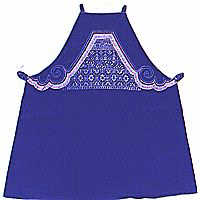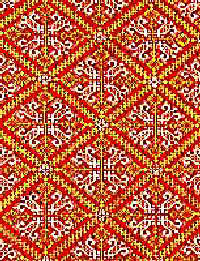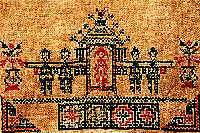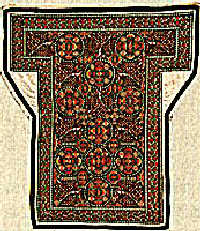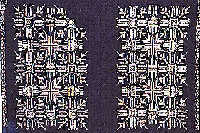Cross-stitching, a type of embroidery, involves stitching one cross after another onto a
fabric grid to form different patterns. Cross-stitched handkerchiefs and clothing
accessories are unsophisticated and simple yet durable.
Cross-stitching is popular all across China (especially in southernShaanxi Province) and
cross-stitched handicrafts are much loved by the Chinese people. Besides theHan
nationality, people of many ethnic minorities in China also adore the craft, including the
Dong, Miao and Qiang people.
In western China's rural areas, cross-stitching is nearly always executed with indigo blue
thread on coarse, white cotton fabric. One- or two-colored embroidery made by peasants is
perhaps the most striking of all, showing off its complex designs.
One of the most important and widespread functions of cross-stitching has been to adorn
peasants' garments and household linen, often as a way of indicating family wealth and
status in the community. Peasant embroidery is a purely domestic skill that is passed down
through generations from mothers to their daughters. The stitching is simple and the fabric
is readily available -- usually in the form of woven linen or cotton. Although thread
colors areoften limited to just two or three types, they are beautifully dyed and often
accentuated by dark brown or black outlines.
Origin and spread
From historical and archaeological evidence, there is not yet enough accurate information
to trace the exact origins of cross-stitched embroidery. Some historians, however, suggest
that the development of cross-stitching is greatly owed to the craftsmanship of the Chinese
since this type of embroidery is known to have flourished during theTang Dynasty(618-907)
and a strong rural tradition of cross stitching still existed in the area during the early
20th century.
Origin and spread
From historical and archaeological evidence, there is not yet enough accurate information
to trace the exact origins of cross-stitched embroidery. Some historians, however, suggest
that the development of cross-stitching is greatly owed to the craftsmanship of the Chinese
since this type of embroidery is known to have flourished during theTang Dynasty(618-907)
and a strong rural tradition of cross stitching still existed in the area during the early
20th century.
It is feasible that techniques and designs spread from China via India and Egypt to the
great civilizations of Greece and Rome and then to the eastern Mediterranean and the Middle
East. An alternative school of thought says that the spread of cross-stitched embroidery
may have gone in the opposite direction since the first important migration of foreigners
into China took place during the Tang Dynasty. Many Persians, Arabs and travelers from
Greece and India followed the silk routes into China and eventually settled there. There is
evidence that these immigrants influenced the designs of Chinese arts and crafts,
particularly textiles. The patterns found on many Chinese textiles are very similar to
those found on Persian fabrics.
The only certainty is that the techniques and designs of cross-stitching spread from such
countries throughout the European continent. Crusaders probably brought home embroidered
textiles from the Middle Eastern countries after the great crusades. The well-traveled
trade and spice caravan routes carried not only merchants and their stock of articles for
sale but also itinerant craftsmen, who practiced their craft wherever they went. The spread
of cross-stitched designs from their place of origin to many different locations makes it
difficult to pinpoint the origin of any one design.
Designs and stitching have been exchanged between so many different cultures and
geographical areas -- via travel, trade and the availability of printed design books --
that many design elements are now common to a number of cultures. Even today, it is
fascinating to see the same motifs recur in traditional peasant embroideries from countries
as far apart as the Greek Islands, Mexico and Thailand. There are many regional variations
of similar cross-stitched shapes, including the eight-pointed star, heart, and flower and
bird motifs, as each basic shape is made to fit the fabric grid in a slightly different
way.
Looking after cross-stitched works
Embroidered items, such as tablemats and napkins,which are intended to be used rather than
displayed, must be laundered at regular intervals to remain in tiptop condition. If you
suspect that the threads may not be colorfast, have the piece dry-cleaned instead of
cleaning it yourself. The best way to clean cross-stitched works is to wash them carefully
by hand in hot water with a mild, detergent-free cleaning agent. Most specialist fabric
shampoos are ideal, but check that they do not contain optical brighteners, which will
cause the thread and fabric colors to fade. Rinse thoroughly several times and then roll in
a towel and press gently to remove surplus water. Gently ease back into shape and dry away
from direct sunlight.
When using table linen, take immediate measures to correct spills and stains: Mop up the
excess liquid withpapertowels or tissues and rinse the fabric under running tepid water.
Scrape off spilled foods quickly and then blot with a paper towel before washing in the
usual way. For stubborn stains, use a solvent or brand-name stain remover, but be sure to
test a small area first; if unsure, seek professional advice. When treating stains,
remember that it is better to repeat a mild treatment several times rather than using a
harsh solvent that may damage both threads and fabrics.
Press the embroidery while it is still slightly damp: Pad an ironing board with a couple of
old, clean towels, then lay the embroidery on with the wrong side up. Cover with a piece of
clean white fabric (a cotton sheet is ideal). Set your iron to a temperature that
corresponds to the fabric's composition, for example, the linen setting for linens,
slightly cooler for Aida and cotton fabrics, and even lower for even-woven fabrics made
from cotton/viscose mixtures. Press lightly, taking care not to flatten the stitches. Old-
fashioned laundry starch will give an attractive, crisp finish to table linen. Make sure
the iron is not too hot.
Before storing the cross-stitched works, make sure they are clean and dry. Avoid storing
fabrics for any length of time in polythene bags since the static electricity created by
polythene attracts dirt and dust which will sully the fabric. Sealed polythene bags also
prevent natural fibers, such as cotton and linen, from "breathing," which can result in
mildew and eventually weaken or rot the fibers. Instead, store small items laid flat, and
larger ones rolled around an acid-free cardboard tube protected by layers of white, acid-
free tissue paper. For items too large to roll up, fold loosely between layers of white
tissue paper, making sure that each fold is padded with tissue. Store all of the items in
their own clean fabric bags in drawers, cupboards or other dark, dry and moth-free places.
Small fabric bags of dried lavender add a sweet scent and help prevent moths.
(
十字绣(cross stitch),是用专用的绣线和十字格布,利用经纬交织的搭十字的方法,对照专用的坐
标图案进行刺绣,任何人都可以绣出同样效果的一种刺绣方法。十字绣是一种古老的民族刺绣,具有悠
久的历史。在我国许多少数民族的日常生活中,一直以来就普遍存在着自制的十字绣的工艺品。由于各
国文化的不尽相同,随着时间的推移,十字绣在各国的发展也都形成了各自不同的风格,无论是绣线、
面料的颜色还是材质、图案,都别具匠心。
)
